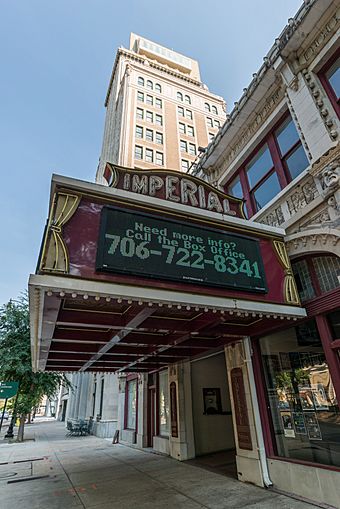Imperial Theatre (Augusta, Georgia) facts for kids
 |
|
| Address | 749 Broad St Augusta, Georgia, 30901 USA |
|---|---|
| Coordinates | 33°28′31″N 81°57′52″W / 33.4754°N 81.9645°W |
| Capacity | 853 |
| Opened | February 18, 1918 |
The Imperial Theatre is a historic performance hall located in downtown Augusta, Georgia, United States. It has 853 seats, making it a great place to watch shows. The theatre first opened its doors on February 18, 1918. It was named after the famous Imperial Theatre in New York City.
Contents
The Theatre's Beginning
The Imperial Theatre started its life in 1917. It was first known as The Wells Theatre. A man named Jake Wells founded it. The theatre was designed by an architect named G. Lloyd Preacher. He created it in a beautiful style called Victorian Renaissance. When it first opened, it was a popular place for vaudeville shows. Vaudeville was a type of entertainment with many different acts. These acts included singers, dancers, comedians, and magicians.
A Time of Change
In October 1918, a health issue caused all public places to close. This included the theatre. During this time, Jake Wells faced money problems. He decided to sell The Wells Theatre to Lynch Enterprises. The theatre reopened in November 1918. It kept the name Jake Wells for a short time. Soon after, Lynch Enterprises bought other theatres in the area. That's when The Wells Theatre officially changed its name to The Imperial Theatre.
From Vaudeville to Movies
By 1929, movies became very popular. Vaudeville shows were not as common anymore. Because of this, the Imperial Theatre was updated. It became a full-time movie house. The theatre was redesigned in the popular Art Deco style. This style is known for its sleek, modern look. In March 1936, a movie called "The Trail of the Lonesome Pine" was shown there. It was special because it was the first color film to play at the Imperial. Famous actors like Henry Fonda and Fred MacMurray starred in it. The theatre is part of the Broad Street Historical District. This means it is an important building in the area's history.
Reopening as a Performance Hall
The Imperial Theatre continued to show movies until 1981. At that time, the downtown area was changing. The theatre eventually closed. But in 1985, people realized how special its architecture was. Local groups, like the Augusta Ballet, helped to reopen it. It became a place for live performances again.
The Imperial Theatre Today
Today, the Imperial Theatre is a busy and exciting place. It hosts many different kinds of entertainment. You can see musicals, dance shows, concerts, and comedy acts. It is still the only historic theatre operating in Augusta. Many local arts groups use the Imperial Theatre. These include the Augusta Ballet and the Augusta Players. Other groups like the Morris Museum of Art's Southern Soul + Song Series also perform there. It is also home to the Poison Peach Film Festival.
Famous Visitors
Many famous people have visited the Imperial Theatre. One of the earliest was Charlie Chaplin. He came to the theatre on April 18, 1918. He was there to help sell war bonds. These bonds helped the country during wartime. Other famous performers also appeared. These included Leo Carrillo, who later became known as Pancho. The world-famous ballet dancer Anna Pavlova also performed there.
See also

